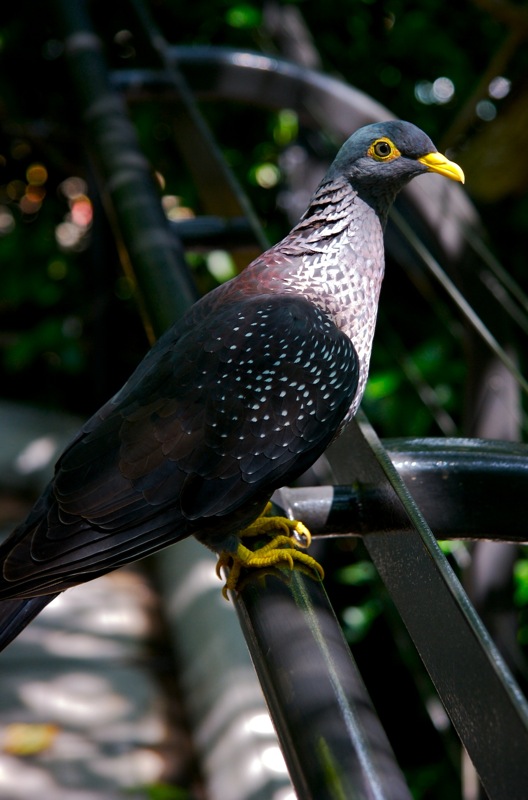- African Olive-pigeon
Taxobox
name = African Olive-pigeon
status = LC | status_system = IUCN3.1

regnum =Animal ia
phylum = Chordata
classis =Aves
ordo =Columbiformes
familia =Columbidae
genus = "Columba"
species = "C. arquatrix"
binomial = "Columba arquatrix"
binomial_authority = Temminck, 1808The African Olive-pigeon or Rameron Pigeon ("Columba arquatrix") is a pigeon which is a resident breeding bird in much of eastern and southern
Africa fromEthiopia to the Cape. There are also populations in westernAngola , southwesternSaudi Arabia and northernYemen . It is locally common, although there are sizeable gaps in its distribution due to its habitat requirements.This is a species of cool, moist forest canopies above 1,400 m altitude, although it occurs locally as low as 700 m. It will use mountain
fynbos , second growth and clearings, and feed on agricultural land when not persecuted.The African Olive-pigeon builds a large stick nest up to 15 m high in a tree and lays one (rarely two) white eggs. The eggs are incubated for 17-20 days to hatching, and the chicks fledge in another 20 days.
The male has a display consisting of deep bows, and a display flight which consists of a climb, wingclapping, and slow glide down. The adult male African Olive-pigeon is a large pigeon at 37-42 cm in length. Its back and wings are maroon, with the shoulders heavily speckled with white spots. The underparts are maroon with heavy white spotting, and the head is grey with yellow patches around the eye, and a yellow bill. The neck plumage, used in display, is streaked maroon and white, the underwing and undertail are dark grey, and the feet are yellow.
Females are very similar but somewhat duller. Juvenile birds have the maroon and grey replaced with dark brown, the bare parts are a dull greenish-yellow, and the wing feathers have pale fringes. In flight, this pigeon looks very dark. Its flight is quick, with the regular beats and an occasional sharp flick of the wings which are characteristic of pigeons in general. The call is a loud "coo coo".
The African Olive-pigeon feeds on fruit and berries, mainly picked in the canopy, but it will also descend for fallen fruit and take some
insect s and caterpillars. In the south of its range, it favours the fruit of the bugweed, "Solanum mauritianum". Birds will fly considerable distances from their roosts to feeding areas, and young or non-breeding birds will form flocks.References
* Gibbs, Barnes and Cox, "Pigeons and Doves" (Pica Press 2001) ISBN 1-873403-60-7
* Ian Sinclair, Phil Hockey and Warwick Tarboton, "SASOL Birds of Southern Africa" (Struik 2002) ISBN 1-86872-721-1ee also
*
Olive-pigeon
Wikimedia Foundation. 2010.
